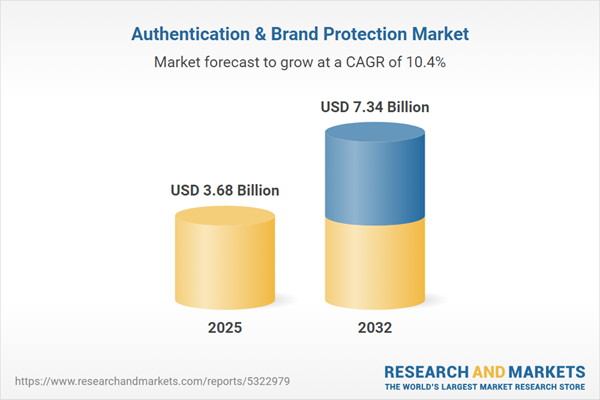Speak directly to the analyst to clarify any post sales queries you may have.
Authentication and brand protection are rapidly becoming critical focal points for enterprises confronting escalating digital threats and an evolving landscape of regulatory requirements. As businesses transition to cloud-driven models and interconnected environments, safeguarding digital identities and maintaining brand integrity are essential for long-term resilience.
Market Snapshot: Authentication & Brand Protection Market Growth
The Authentication & Brand Protection Market grew from USD 3.34 billion in 2024 to USD 3.68 billion in 2025. This sector continues to expand at a compound annual growth rate (CAGR) of 10.35%, with projections indicating it will reach USD 7.34 billion by 2032.
Scope & Segmentation of the Authentication & Brand Protection Market
This report delivers a comprehensive analysis of the authentication and brand protection landscape, providing deep visibility into key technologies, applications, organizational requirements, and regional adaptations shaping market evolution.
- Solution Categories: Identity access management, multi-factor authentication, privileged access management, single sign-on
- Identity Access Management – Consumer: Customer registration, profile management, social login
- Identity Access Management – Workforce: Access governance, credential management, role management
- Multi-Factor Authentication Methods: Biometric, one time password, push notification, SMS
- Deployment Types: Cloud (private, public), hybrid, on premises
- Application Types: Enterprise, mobile, web
- Authentication Methods: Biometric (facial recognition, fingerprint, iris), knowledge-based (password, security question), risk-based (behavioral analytics, device fingerprinting), token-based (hardware, software)
- Organization Sizes: Large enterprises, small and medium enterprises
- End User Industries: BFSI (Banking, Financial Services, and Insurance), government, healthcare, IT & telecom, retail & e-commerce
- Regions Covered: Americas (including United States, Canada, Mexico, Brazil, Argentina, Chile, Colombia, Peru), Europe, Middle East & Africa (including major European markets such as United Kingdom, Germany, France, Russia, Italy, Spain, Netherlands, Sweden, Poland, Switzerland; Middle East including UAE, Saudi Arabia, Qatar, Turkey, Israel; Africa including South Africa, Nigeria, Egypt, Kenya), and Asia-Pacific (including China, India, Japan, Australia, South Korea, Indonesia, Thailand, Malaysia, Singapore, Taiwan)
- Competitive Coverage: Analysis of leading players such as Thales S.A., IDEMIA Group, HID Global, Okta, Entrust, CyberArk, Ping Identity, OneSpan, ForgeRock, and Daon
Key Takeaways for Senior Decision-Makers
- Organizations are shifting toward identity-centric security, adopting contextual signals to strengthen access controls and reduce reliance on legacy authentication.
- Brand protection strategies are evolving from reactive measures to predictive monitoring, leveraging advanced analytics and machine learning to identify digital threats early.
- The market trend favors cloud-based solutions for flexibility, scalability, and ease of regulatory compliance—particularly attractive in distributed work environments.
- Regional compliance demands, including data sovereignty and privacy laws, are driving local adaptations in deployment models and service delivery approaches.
- Partnerships between established access management vendors and emerging fintech innovators are integrating advanced risk analytics into authentication workflows and enhancing contextual visibility.
- Industry leaders are embracing modular architectures and open standards as a way to accelerate innovation, foster interoperability, and reduce vendor lock-in risks.
Tariff Impact on Authentication & Brand Protection Technologies
In 2025, heightened United States tariffs on technology hardware have prompted a pivot toward software-driven and cloud-native authentication solutions. Hardware-based products now face increased costs, encouraging migration to platforms that minimize import duties and support rapid, distributed implementation. Brand protection services have adapted through SaaS models and regional hosting, enabling continuity and cost control within shifting global supply chains.
Methodology & Data Sources
This research utilizes a multi-phase methodology that includes primary interviews with sector experts and stakeholders, robust secondary analysis of regulatory literature and vendor data, as well as rigorous validation procedures. Quantitative findings were peer-reviewed, and all data triangulated to maximize accuracy and transparency.
Why This Report Matters for Enterprise Leaders
- Enables informed strategic investments by mapping solution types, deployment preferences, and regional dynamics within the authentication & brand protection market.
- Assists in technology and vendor selection by providing a clear, factual assessment of segment innovations, compliance drivers, and risk mitigation strategies.
- Supports resilience planning with actionable recommendations grounded in current threat, regulatory, and operational contexts.
Conclusion
Leveraging integrated authentication and brand protection strategies equips organizations to address digital threats, adapt to regulatory demands, and reinforce customer trust. Enterprises that operationalize these insights are well-positioned for secure, efficient business transformation.
Additional Product Information:
- Purchase of this report includes 1 year online access with quarterly updates.
- This report can be updated on request. Please contact our Customer Experience team using the Ask a Question widget on our website.
Table of Contents
3. Executive Summary
4. Market Overview
7. Cumulative Impact of Artificial Intelligence 2025
Companies Mentioned
The companies profiled in this Authentication & Brand Protection market report include:- Thales S.A.
- IDEMIA Group
- HID Global Corporation
- Okta, Inc.
- Entrust Corporation
- CyberArk Software Ltd.
- Ping Identity Holding Corp.
- OneSpan, Inc.
- ForgeRock, Inc.
- Daon, Inc.
Table Information
| Report Attribute | Details |
|---|---|
| No. of Pages | 192 |
| Published | October 2025 |
| Forecast Period | 2025 - 2032 |
| Estimated Market Value ( USD | $ 3.68 Billion |
| Forecasted Market Value ( USD | $ 7.34 Billion |
| Compound Annual Growth Rate | 10.3% |
| Regions Covered | Global |
| No. of Companies Mentioned | 11 |









